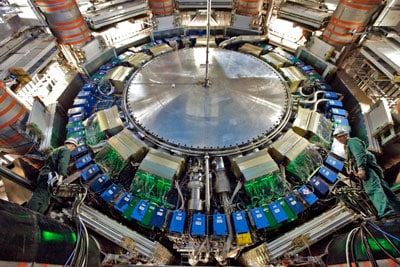
The first solid experimental evidence for the existence of the Higgs boson has been unveiled today by physicists working on the Large Hadron Collider (LHC) at CERN in Geneva. Members of the ATLAS experiment revealed evidence that the Higgs particle has a mass of about 126 GeV/c2. Physicists working on the rival CMS experiment released similar – albeit weaker – evidence for a Higgs with a mass of about 124 GeV/c2.
However, ATLAS spokesperson Fabiola Gianotti cautions that the measurements are not good enough yet to claim the discovery of the particle.
Physicists are keen to discover the Higgs boson to complete the Standard Model of particle physics. The particle and its associated field are needed to explain how electroweak symmetry broke just after the Big Bang – which gave certain elementary particles the property of mass. The Standard Model does not, however, actually predict the mass of the Higgs, and successive experimental programmes at CERN’s Large Electron–Positron Collider, Fermilab’s Tevatron and now the LHC have sought to measure its mass.
If the current glimpse of the Higgs proves to be an illusion, and it – or a similar symmetry-breaking entity – is never found, all would not be lost, as physicists would be forced to concede that the Standard Model is incomplete and to look for “new physics” beyond it.
Evidence versus discovery
The ATLAS measurement was made at a confidence level of about 3.6σ, which means that the measurement could be the result of a random fluke just 0.1% of the time. While these might sound like fantastic odds, particle physicists normally wait until they have a confidence of 5σ or greater before they call it a “discovery”. Anything above 3σ is described as “evidence”.
There are several reasons why particle physicists require such high confidence levels. One is the “look elsewhere” effect that arises because the data are sorted into mass/energy bins to create a histogram – which could concentrate fluctuations. After the look elsewhere effect is considered in the ATLAS result, the confidence level drops to 2.3σ, according to Gianotti.
Another potential problem is that there could be unknown systematic errors lurking in the experiment that could be responsible for the apparent result, and therefore requiring a very high confidence could help avoiding such errors.
Despite the preliminary results announced at CERN today, unravelling the mystery of the Higgs will take some time. Assuming that the signal at 126 GeV/c2 survives further analysis, the next step for physicists will be to tease out the precise nature of the Higgs they have discovered. According to Matt Strassler of Rutgers University in the US, a mass of about 126 GeV/c2 could indicate many different things. These include a Standard Model Higgs, a Higgs that is best described by theories beyond the Standard Model such as supersymmetry (SUSY), a “little Higgs” or various other theories.
Different reactions
To gain a better understanding of the Higgs, Strassler says that several different reactions that produce the Higgs at the LHC must be studied, as well as several different decay channels of the particle. In particular, physicists must find out how closely the Higgs is described by the Standard Model, which involves studying interactions involving W and Z particles, top and bottom quarks, and tau leptons.
In total, he believes that seven or eight different measurements are required before physicists will have a handle on the Higgs. “Next year we could be in a position to say that we have a particle that’s reasonably consistent with the Standard Model,” says Strassler. This would allow physicists to eliminate theories – such as technicolor – that do not include the Higgs particle.
“By 2014/2015 we could have enough additional data to eliminate large classes of theories that attempt to explain the Higgs,” adds Strassler, although he warns that it could take as long as 10 years to gain a full understanding of the particle.
However, not all physicists believe that the road to understanding the Higgs will be a long one. Gordon Kane of the University of Michigan and colleagues have recently published a preprint on the arXiv server that calculates the mass of the Higgs using string theory – calculations that put the Higgs mass in the 122–129 GeV/c2 range. Kane told physicsworld.com that physics beyond the Standard Model has “jumped out as string theory”. “The game is over and we have won – we have landed on the shores of a new world,” he adds.
For more information about the search for the Higgs, watch our video with Guido Tonelli, spokesperson for the CMS experiment, and ATLAS researcher Pippa Wells.



